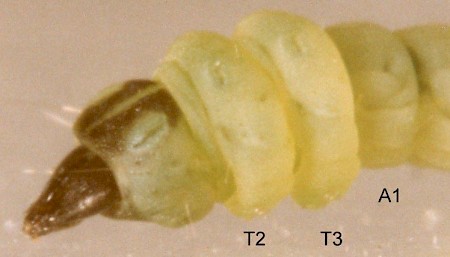10.003 BF125
Coptotriche marginea
(Haworth, 1828)
[Synonyms: Emmetia marginea]Wingspan 7-8 mm.
A common species throughout Britain, having two generations, the moths flying in May and June, and again in August.
The larvae mine the leaves of bramble (Rubus), creating a funnel-shaped blotch, the second generation feeding through the winter.
The moths are small, indistinct brownish insects with a slight metallic sheen.
- Larva: (description Ian F. Smith):
Foodplant: In a funnel shape leaf mine on Rubus, usually R. fruticosus agg., in July and (in an evergreen variety) September to March. Overwintering larvae feed in mild weather and can be forced in warmth. Frass is expelled from the mine, which contains a silk tunnel occupied by the larva when at rest. When feeding, the larva can be seen through the mine, and the distinctive black anvil on T1 discerned.
Length: 5 mm in October described.
Head: Compressed vertically into a thin black wedge. Frons outlined in greenish yellow.
Prothorax (T1): Integument a stronger green than rest of body, especially when viewed from the side. Prothoracic shield weakly sclerotised, divided by broad greenish medial line. Both dorsally and ventrally, subcutaneous black pigment covered by transparent shagreened green tinted cuticle. Opaque greenish lateral discs impose an anvil outline on the black areas.
Thorax (T2&T3): Thoracic segments 2 and 3 are markedly swollen and larger than the abdominal segments. They, with T1 and the compressed head, make a powerful wedge, well adapted to shallow leaf mining under the upper leaf surface.
Thoracic legs: Reduced to tiny vestigial warts, the large deeply incised thoracic segments being a better adaptation to locomotion within the mine.
Body: Thinner than thorax and strongly tapering to the anal segment. Deeply incised intersegmentally. Integument shagreened greenish yellow, slightly translucent showing green contractile vessel as a faint dorsal line. The gut can be detected as a dark shadow intersegmentally, ventrally, and generally on A8, A9 and A10.
Spiracles: Small and difficult to discern. Thin faint brown peritreme.
Pinacula: Small. Coloured as body. Dorsal pinacula on abdomen are bisetose.
Setae: Colourless, transparent.
Anal segment: No anal comb. Anal plate translucent brown, darkened when frass in transit.
Prolegs: Vestigial yellow stumps. (MBGBI - 1 page 272 says absent, but they are visible in lateral view image on this web site.) Crochets pale reddish brown.

 UKMoths
UKMoths 





